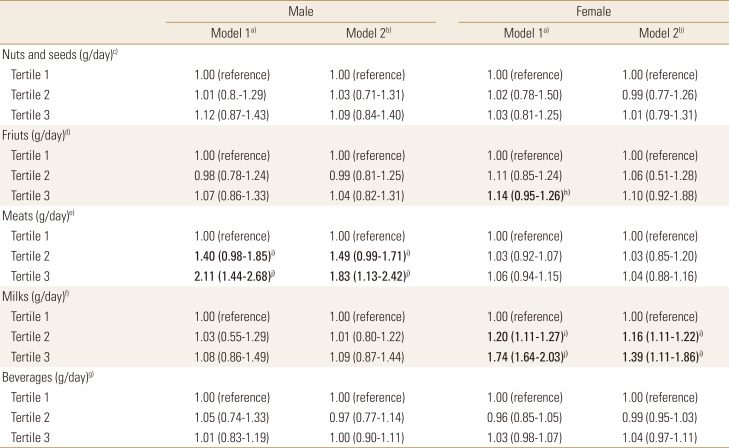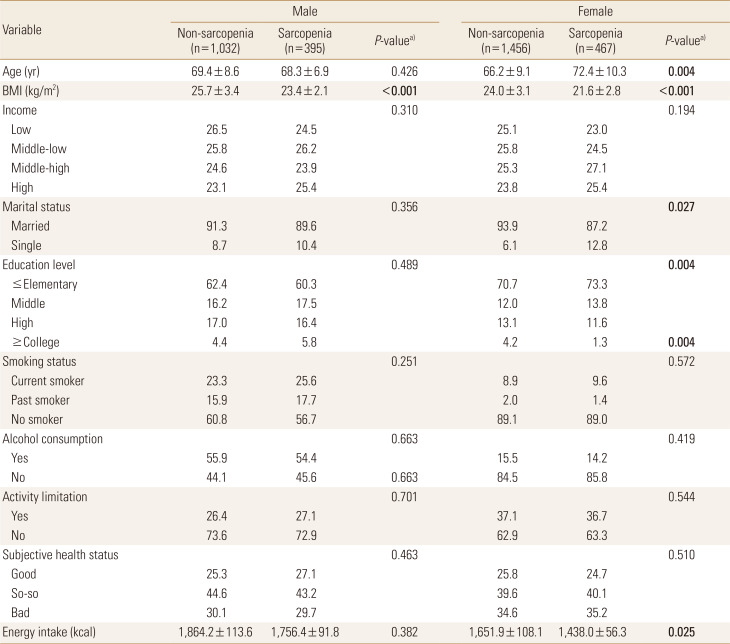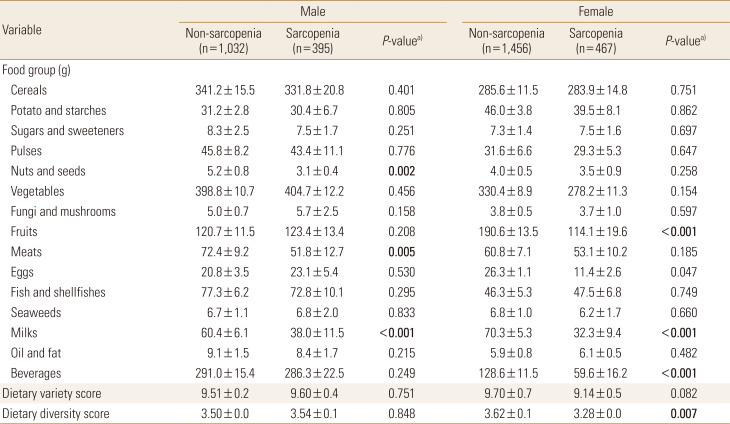1. Park MH. Comparative study on ageing society: Korea and EU. Korean J EU Stud 2011;16:99-126.
2. Hughes VA, Frontera WR, Roubenoff R, et al. Longitudinal changes in body composition in older men and women: role of body weight change and physical activity. Am J Clin Nutr 2002;76:473-481.


3. Poggiogalle E, Lubrano C, Sergi G, et al. Sarcopenic obesity and metabolic syndrome in adult Caucasian subjects. J Nutr Health Aging 2016;20:958-963.


5. Tian HY, Qiu R, Jing LP, et al. Alternate Mediterranean diet score is positively associated with skeletal muscle mass index in middle-aged adults. Br J Nutr 2017;117:1181-1188.


7. Gautsch TA, Kandl SM, Donovan SM, et al. Growth hormone promotes somatic and skeletal muscle growth recovery in rats following chronic protein-energy malnutrition. J Nutr 1999;129:828-837.


8. Liao CD, Chen HC, Huang SW, et al. The role of muscle mass gain following protein supplementation plus exercise therapy in older adults with sarcopenia and frailty risks: a systematic review and meta-regression analysis of randomized trials. Nutrients 2019;11:1713.

10. Remelli F, Vitali A, Zurlo A, et al. Vitamin D deficiency and sarcopenia in older persons. Nutrients 2019;11:2861.


11. Damiano S, Muscariello E, La Rosa G, et al. Dual role of reactive oxygen species in muscle function: can antioxidant dietary supplements counteract age-related sarcopenia? Int J Mol Sci 2019;20:3815.


12. Chaput JP, Lord C, Cloutier M, et al. Relationship between antioxidant intakes and class I sarcopenia in elderly men and women. J Nutr Health Aging 2007;11:363-369.

13. Janssen I, Heymsfield SB, Ross R. Low relative skeletal muscle mass (sarcopenia) in older persons is associated with functional impairment and physical disability. J Am Geriatr Soc 2002;50:889-896.


15. Randall E, Nichaman MZ, Contant CF Jr. Diet diversity and nutrient intake. J Am Diet Assoc 1985;85:830-836.

16. Kant AK, Block G, Schatzkin A, et al. Dietary diversity in the US population, NHANES II, 1976-1980. J Am Diet Assoc 1991;91:1526-1531.

18. Heymsfield SB, Gonzalez MC, Lu J, et al. Skeletal muscle mass and quality: evolution of modern measurement concepts in the context of sarcopenia. Proc Nutr Soc 2015;74:355-366.


19. Lidoriki I, Schizas D, Mpaili E, et al. Associations between skeletal muscle mass index, nutritional and functional status of patients with oesophago-gastric cancer. Clin Nutr ESPEN 2019;34:61-67.


20. Doherty TJ. The influence of aging and sex on skeletal muscle mass and strength. Curr Opin Clin Nutr Metab Care 2001;4:503-508.

21. Shimokata H, Ando F, Yuki A, et al. Age-related changes in skeletal muscle mass among community-dwelling Japanese: a 12-year longitudinal study. Geriatr Gerontol Int 2014;14 Suppl 1:85-92.


22. Davidson LE, Kelley DE, Heshka S, et al. Skeletal muscle and organ masses differ in overweight adults with type 2 diabetes. J Appl Physiol (1985) 2014;117:377-382.

23. Lo YT, Chang YH, Lee MS, et al. Dietary diversity and food expenditure as indicators of food security in older Taiwanese. Appetite 2012;58:180-187.


24. Bloom I, Shand C, Cooper C, et al. Diet quality and sarcopenia in older adults: a systematic review. Nutrients 2018;10:308.


25. Foote JA, Murphy SP, Wilkens LR, et al. Dietary variety increases the probability of nutrient adequacy among adults. J Nutr 2004;134:1779-1785.


26. Kumagai S, Watanabe S, Shibata H, et al. Effects of dietary variety on declines in high-level functional capacity in elderly people living in a community. Nihon Koshu Eisei Zasshi 2003;50:1117-1124.

27. Silva TRD, Martins CC, Ferreira LL, et al. Mediterranean diet is associated with bone mineral density and muscle mass in postmenopausal women. Climacteric 2019;22:162-168.










 PDF Links
PDF Links PubReader
PubReader ePub Link
ePub Link Full text via DOI
Full text via DOI Full text via PMC
Full text via PMC Download Citation
Download Citation Print
Print




